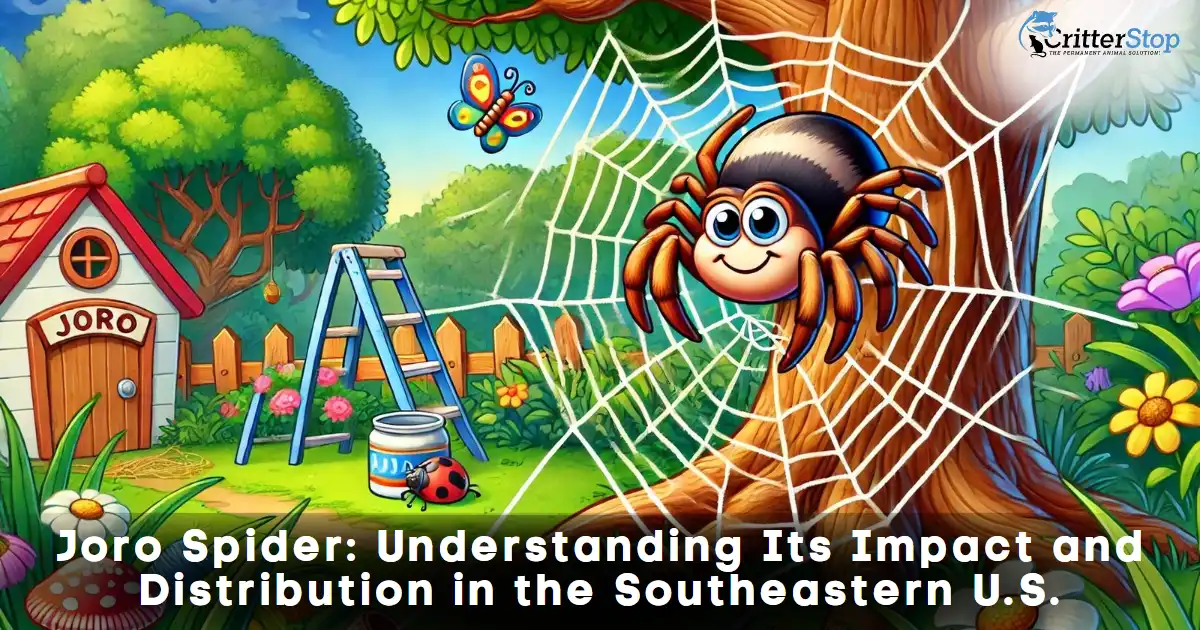
The Joro spider, known scientifically as Trichonephila clavata, has garnered attention for its striking appearance and rapid spread in the southeastern United States. This spider is not only visually captivating with its vibrant yellow and blue coloration but is also a subject of interest due to its ecological impact and adaptability.
Originating from East Asia, the Joro spider has established a population in the U.S., raising questions about its role in local ecosystems. Observers are keen to learn more about its behavior, diet, and potential effects on native species.
As these spiders continue to thrive, they prompt both curiosity and concern among residents. Understanding their habits and ecological significance can provide insights into how they interact with their surroundings and what this means for the environments they inhabit.
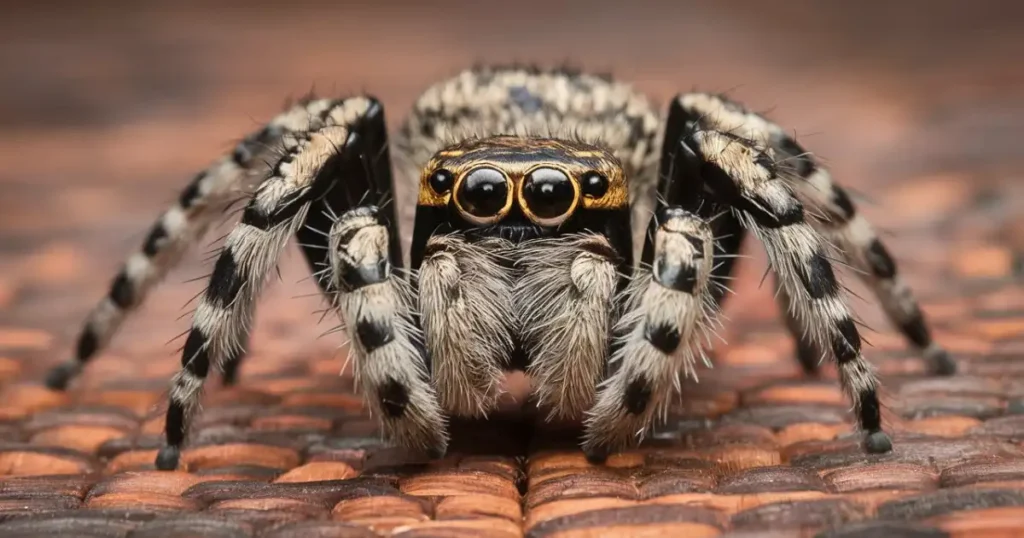
The Joro spider is a distinct arachnid known for its striking appearance and size. Understanding its visual characteristics and how to differentiate it from similar species is crucial for proper identification.
The Joro spider (Trichonephila clavata) features a vibrant color palette. Its body is predominantly yellow with black stripes and red markings on the abdomen, creating a striking pattern. The legs are long and banded in black and yellow, which adds to its distinctive look.
In terms of size, adult Joro spiders can reach approximately 3-4 inches in leg span. Females are typically larger than males, with bodies that can grow up to 1.5 inches long. The combination of these features makes the Joro spider easy to spot in its natural habitat.
The Joro spider is often confused with the banana spider (Nephila species), which also has a prominent appearance. Key differences exist between the two.
The banana spider possesses a more elongated body and distinct yellow markings that are less bold than those of the Joro spider. While both spiders feature a similar web structure, the Joro spider's web is more elaborate.
To differentiate:
These characteristics help in accurately identifying the Joro spider, particularly in areas where both species may coexist.
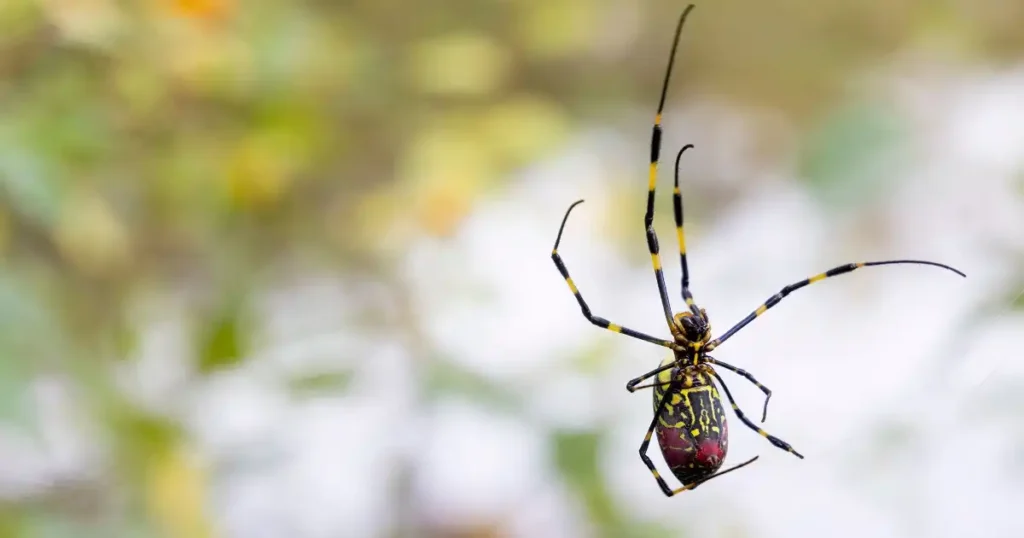
The Joro Spider is native to East Asia and has adapted to various environments. Its spread in the United States has raised interest due to its unique characteristics and potential impact on local ecosystems.
Originally, the Joro Spider (Trichonephila clavata) is found in regions such as Japan, Korea, China, and Taiwan. It thrives in temperate climates, preferring habitats that include forests, gardens, and urban areas.
These spiders often construct large, intricate webs in sheltered locations. They are commonly found in shrubs, trees, and areas near water sources. The specific choice of habitat enables them to access prey effectively while providing protection from predators.
In recent years, joro spider texas has made its debut, first reported in 2020. Its adaptation to the local environment has been swift, allowing it to establish populations across various counties.
Factors contributing to this expansion include the state's warm climate and diverse landscapes. The spider has been sighted in urban, suburban, and rural areas, often where suitable web-building sites are available.
Residents have noted sightings in gardens and near homes, indicating the spider's ability to thrive alongside human activity. Ongoing research aims to monitor its potential effects on local ecosystems and its interaction with native species.
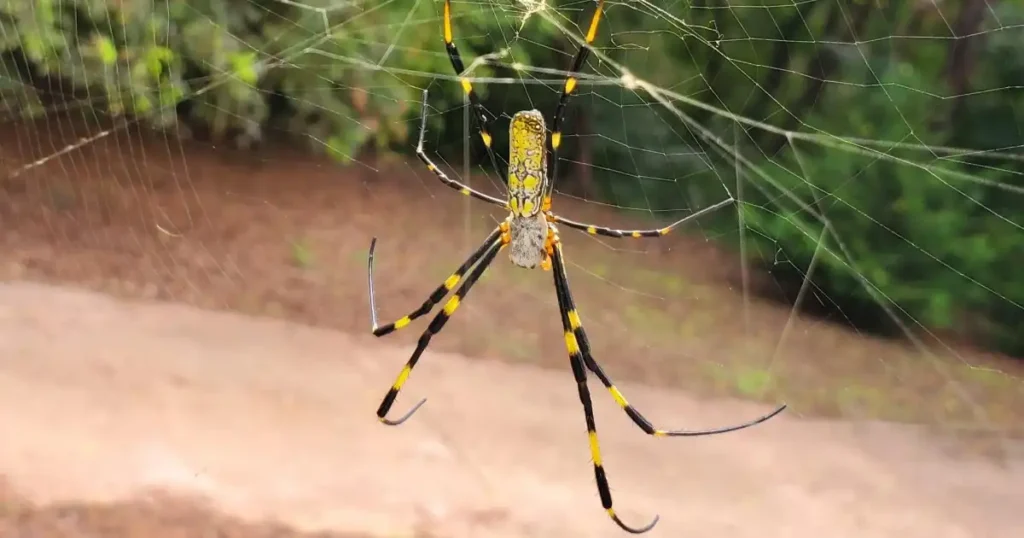
The Joro spider is known for its intricate web construction and unique structural properties. This section explores the weaving techniques employed by Joro spiders and the notable characteristics of their webs.
Joro spiders exhibit remarkable weaving techniques that enable them to create large and complex webs. Their approach involves several stages, starting with the construction of a framework.
The silk produced by Joro spiders is both strong and elastic, allowing them to build webs that can withstand various environmental conditions. These webs can measure up to 3 feet in diameter, showcasing the spider's ability to produce extensive and effective traps.
The Joro spider web possesses distinct properties that enhance its functionality.
These properties make the web highly effective for capturing prey while also being resistant to weather-related damage. The combination of strength and stickiness allows Joro spider webs to remain intact in humid and rainy environments.
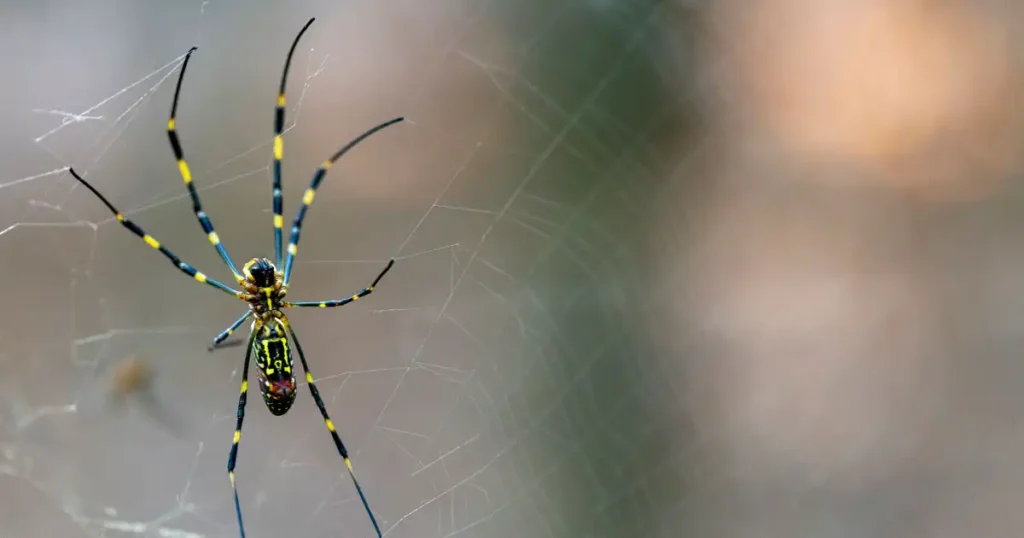
The Joro spider undergoes a fascinating reproductive process with distinct stages of development, from mating to the emergence of juveniles. Understanding these stages offers insight into their population dynamics and ecological role.
Mating occurs primarily in the late summer and early fall. Male Joro spiders engage in courtship displays to attract females. They perform intricate movements and may vibrate their webs to signal their presence.
Once the female accepts a male, copulation takes place. The male must be cautious, as females sometimes consume males after mating. After successful mating, the female lays fertilized eggs in a silk sac, which she carefully constructs.
After about two weeks, the eggs hatch into small baby Joro spiders. These spiderlings emerge in clusters and begin dispersing to find food and suitable habitats.
Development continues as they mature through several molts, which can take several months. Young spiders progress through the instar stages, growing significantly with each molt.
Typically, Joro spiders reach adulthood in approximately 60 to 90 days. Adults exhibit distinctive coloration and patterns, making them easy to identify. This life cycle demonstrates their adaptability in various environments.
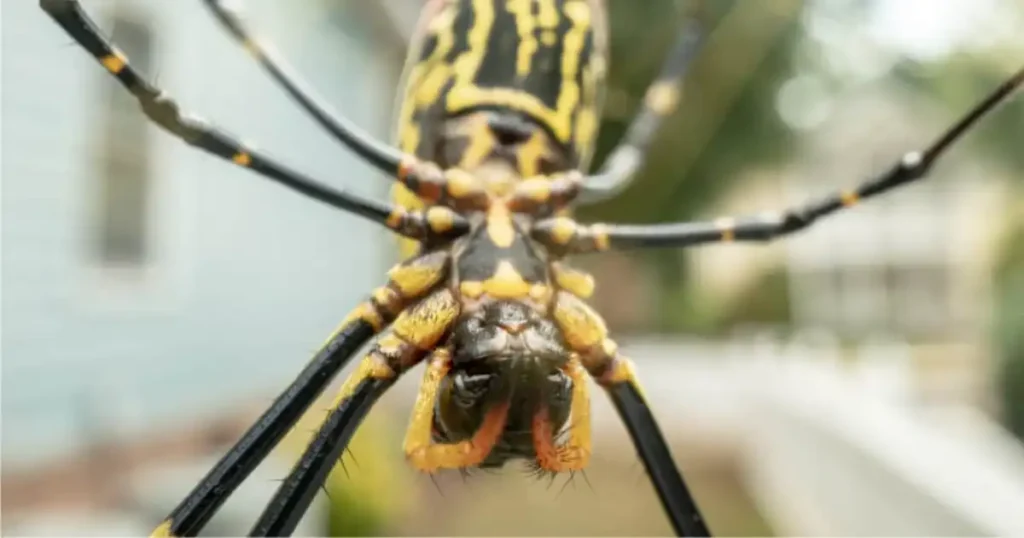
Joro spiders primarily feed on insects, playing a significant role in their ecosystem. Understanding their dietary habits and natural threats provides insight into their behavioral ecology and impact on local fauna.
Joro spiders are known for their diverse diet, which mainly consists of insects. They effectively capture prey using their intricate webs, which are designed to ensnare various flying and crawling insects. Common targets include:
These spiders are opportunistic feeders. They consume whatever insects become trapped in their webs. Once captured, Joro spiders inject venom into their prey, immobilizing it before consumption. The digestion process includes external digestion, where enzymes break down tissues prior to ingestion. This feeding strategy allows Joro spiders to thrive in various habitats.
Despite their predatory skills, Joro spiders have natural enemies. These predators help regulate their population. Key predators include:
Additionally, environmental factors and habitat changes can impact their survival rate against these predators. The presence of predators plays a crucial role in maintaining ecological balance within their habitat.
The ecological impact of the Joro spider is significant due to its status as an invasive species and its effects on local ecosystems. Understanding these dynamics is crucial for assessing its influence on biodiversity and interactions within the environment.
This interesting spider (Trichonephila clavata) has emerged as an invasive joro spider species primarily in the southeastern United States. Native to East Asia, its introduction has raised concerns among ecologists.
This spider reproduces rapidly, with females capable of laying hundreds of eggs. Its adaptability to various habitats allows it to thrive in urban and rural environments alike.
Potential impacts include:
The introduction of the Joro spider alters local food webs and community dynamics. By preying on various insects, it can influence the populations of both pests and beneficial species.
While it targets a wide range of insects, its effect on specific local populations is still under study. Initial observations suggest that potential prey species, such as pollinators, may face increased pressure.
Considerations include:
These factors emphasize the importance of monitoring the Joro spider's spread to mitigate potential ecological consequences.
Joro spiders have become increasingly prevalent, leading to various cultural interactions and management strategies. Understanding these aspects can benefit communities and individuals living in areas inhabited by these spiders.
Joro spiders are noteworthy within their ecosystems and hold cultural fascination. Native to East Asia, their introduction to the United States has sparked curiosity and concern among residents. In some cultures, spiders symbolize creativity and patience, attributing a positive aspect to their presence.
In contrast, the appearance of Joro spiders can be alarming due to their size and distinctive coloration. Their silk, recognized for strength, can inspire art and craftsmanship. Communities may view their presence as an opportunity to educate individuals about spider biology and biodiversity, fostering a deeper appreciation for local wildlife.
Managing Joro spiders involves simple strategies that can effectively reduce their presence. To learn how to keep joro spiders away, it is essential to minimize their habitats. This includes:
If Joro spiders do invade, consider gentle removal methods. Relocate them outdoors rather than employing harmful pesticides. Their role in controlling insect populations can be beneficial, contributing positively to local ecosystems. Maintaining a balance between coexistence and management is key.
Many myths surround the Joro spider, and these can lead to misunderstandings about its behavior and impact. Distinguishing between misconceptions and facts is vital for awareness and education.
One common misconception is that Joro spiders can fly. While they do not have wings, they can travel short distances by ballooning, which involves releasing silk strands that catch the wind. This can make it appear as though they are joro spider flying.
Another belief is that Joro spiders are dangerous to humans. In reality, they are nonvenomous and pose no significant threat. They are more likely to retreat when faced with humans.
Joro spiders are often confused with other species, such as the brown recluse. Unlike the recluse, Joros have distinct markings and are larger in size, making identification easier.
Several myths exaggerate the impact of Joro spiders on local ecosystems. For example, some claim that these spiders will cause a decline in native insect populations. In fact, they primarily feed on pests like flies and mosquitoes, potentially benefiting the environment by keeping these populations in check.
Another myth asserts that their webs are a nuisance or hazardous. Despite their large, intricate webs, these structures are typically not harmful. They can even be beneficial for catching unwanted insects.
Public fear often arises from unfamiliarity. Educating communities about the harmless nature of Joro spiders can help reduce anxiety and promote coexistence.
This section addresses common inquiries regarding Joro spiders. It covers their size, bite implications, silk production, venom potential, geographical presence, and ecological impact.
Joro spiders are relatively large, with a body length ranging from 1 to 1.5 inches, not including their legs. When fully extended, their leg span can reach up to 4 inches. This size places them among the larger spider species often found in residential areas.
A Joro spider bite is generally not harmful to humans. While their bites can cause minor irritation and localized pain, they are not known to pose serious health risks. Most individuals experience only mild symptoms, similar to a common insect bite.
Yes, Joro spiders can produce silk and spin webs. They create intricate, large webs that are often used to trap prey. Their webs are known for being strong and visually striking, typically featuring a distinctive yellow coloration.
Joro spiders are not considered a significant venomous threat to humans. Although they possess venom to subdue prey, it is not potent enough to cause serious harm to people. Most encounters with Joro spiders are harmless.
Joro spiders are primarily found in the southeastern United States. They have been reported in states such as Georgia, South Carolina, and North Carolina. Their range may expand as they adapt to new environments.
Joro spiders may influence local ecosystems by preying on various insects. By controlling pest populations, they can contribute to overall ecological balance. Their presence may also serve as a food source for larger predators in the area.
Homeowners facing issues with Joro Spiders can rely on Critter Stop for effective pest control solutions. As a professional humane wildlife removal company, they focus on safe and efficient practices.
Critter Stop offers free inspections to assess the severity of the spider problem. By calling (214) 234-2616, residents can schedule an appointment with knowledgeable technicians who understand how to handle infestations.
The company prides itself on its fantastic reputation and positive customer reviews. Clients appreciate the quality of work and the excellent customer service provided by Critter Stop team members.
Services include:
Using a humane approach, Critter Stop ensures that customers feel comfortable with the solutions offered. Their expertise can help mitigate concerns regarding Joro Spiders and other pest-related issues.
Regular communication and updates during the process keep clients informed and involved. This commitment to service enhances customer satisfaction and builds trust in their approach.
For proactive pest control and peace of mind, Critter Stop is a reliable choice for residents seeking to eliminate Joro Spiders.
Visit our Critter Library and learn more about our furry friends